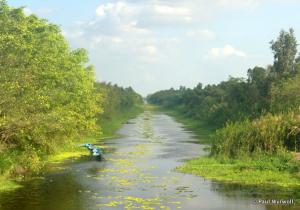 Densely populated and intensively farmed, the Mekong Delta is an unmistakably man-made landscape. A vast canal network delivers water to the rice fields and fish farms that provide the foundation of Vietnam’s economy and its position as a globally significant food exporter.
Densely populated and intensively farmed, the Mekong Delta is an unmistakably man-made landscape. A vast canal network delivers water to the rice fields and fish farms that provide the foundation of Vietnam’s economy and its position as a globally significant food exporter.
Dotted amidst the agricultural land, however, there are a number of small national parks. These areas provide refuge for plant and animal species, as well as ecosystem services like protection from floods and storm surges. Perhaps the most important from a conservation perspective is U Minh Thuong National Park. Situated in the southwestern province of Kien Giang, the park is approximately 12km long and 6km wide. Notwithstanding this small area, U Minh Thuong is home to approximately 200 species of plants, 50 types of mammals, and over 180 varieties of birds, many of which are endangered.
 U Minh Thuong National Park is part of the Kien Giang Biosphere Reserve (KGBR), a network of three national parks and surrounding areas that was officially recognized as a UNESCO biosphere reserve in 2006. The KGBR is the site of the ‘Conservation and Development of the Kieng Giang Biosphere Reserve Project’ that is funded by the Australian aid program. The project is implemented under a delegated cooperation agreement by Deutsche Gesellschaft für Internationale Zusammenarbeit (GIZ), an international aid and development enterprise owned by the German government. ‘Delegated cooperation’ involves one donor financing the implementation of a project by another donor already working in the targeted sector, and thereby reducing duplication in administration and other costs that can reduce aid effectiveness.
U Minh Thuong National Park is part of the Kien Giang Biosphere Reserve (KGBR), a network of three national parks and surrounding areas that was officially recognized as a UNESCO biosphere reserve in 2006. The KGBR is the site of the ‘Conservation and Development of the Kieng Giang Biosphere Reserve Project’ that is funded by the Australian aid program. The project is implemented under a delegated cooperation agreement by Deutsche Gesellschaft für Internationale Zusammenarbeit (GIZ), an international aid and development enterprise owned by the German government. ‘Delegated cooperation’ involves one donor financing the implementation of a project by another donor already working in the targeted sector, and thereby reducing duplication in administration and other costs that can reduce aid effectiveness.
The KGBR Project began in Kien Giang in 2008 as a pilot project. In its second phase (2011-2016) the project was expanded to four other provinces in the Mekong Delta and renamed the ‘Climate Change and Coastal Ecosystems Program’. Publicly available documents (here and here) indicate that Australian government funding for the second phase is valued at $US 24.3 million and GIZ is contributing technical assistance to the value of US$ 14.1 million. In addition, the German government is contributing $25.3 million to finance construction of coastal dykes. Precise figures on the contribution of the Australian government to the KGBR in the second phase do not appear to be available from the Department of Foreign Affairs and Trade (DFAT) website, but the phase one review document [pdf] authored by GIZ indicates that the KGBR remains the focus of the expanded project’s activities in phase two. Suffice to say that U Minh Thuong is an important site of a multi-million dollar DFAT/GIZ project.
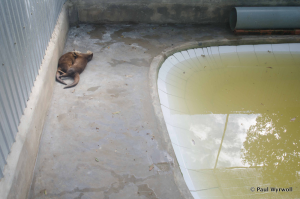 The stated overall objective of the KGBR Project is to support utilisation of “the natural resources of Kien Giang Province in a sustainable way with effective management of the protected areas”. An indicator of the broad progress that has been made towards this objective in U Minh Thuong is an estimated 33% increase in the park’s waterbird population from 2009-2013 [pdf]. Project activities include biodiversity assessment, sustainable livelihood development for local communities and education programs for local officials. Particularly relevant to the issues discussed in the remainder of this post are two of the five main activities:
The stated overall objective of the KGBR Project is to support utilisation of “the natural resources of Kien Giang Province in a sustainable way with effective management of the protected areas”. An indicator of the broad progress that has been made towards this objective in U Minh Thuong is an estimated 33% increase in the park’s waterbird population from 2009-2013 [pdf]. Project activities include biodiversity assessment, sustainable livelihood development for local communities and education programs for local officials. Particularly relevant to the issues discussed in the remainder of this post are two of the five main activities:
- “Improved management of the protected areas, coastal forests, and the conservation of endangered species.
- Awareness programme materials on the importance and relevance of biodiversity and protection of natural ecosystems”
In August 2013, I completed a one-year Australian volunteer assignment working with an environmental research organisation in Vietnam. Over the next six months I traveled to different national parks in the Lower Mekong Basin as a tourist.
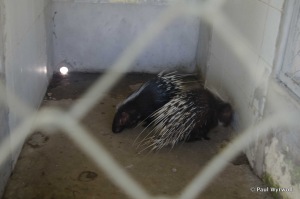 On January 28 this year I visited U Minh Thuong National Park. Near the central visitors’ reception area there is a wetland containing buildings and other features to support tourism. There I witnessed a range of animals being kept in captivity in what can only be described as completely unacceptable conditions (see photos). The species included macaque monkeys, otters, porcupines, waterbirds, an osprey, mongooses, and a crocodile. The Siamese crocodile is a critically endangered species; the otters are either hairy-nosed otters or oriental small-clawed otters that are considered to be endangered and threatened species respectively. In addition to the enclosures documented in the photos, other animals seemed to be held in enclosures and small islands elsewhere within the wetland.
On January 28 this year I visited U Minh Thuong National Park. Near the central visitors’ reception area there is a wetland containing buildings and other features to support tourism. There I witnessed a range of animals being kept in captivity in what can only be described as completely unacceptable conditions (see photos). The species included macaque monkeys, otters, porcupines, waterbirds, an osprey, mongooses, and a crocodile. The Siamese crocodile is a critically endangered species; the otters are either hairy-nosed otters or oriental small-clawed otters that are considered to be endangered and threatened species respectively. In addition to the enclosures documented in the photos, other animals seemed to be held in enclosures and small islands elsewhere within the wetland.
The visible mistreatment of animals is not unusual in Vietnam. In fact, these scenes are relatively benign when placed in the context of broadly held social values that principally consider animals as resources to be exploited. These values are manifest in brutal methods for preparing dog meat, bear bile farms, and Hanoi being the main destination for poached African rhinoceros horn because – at US$6,000 for 100g – ground rhino horn is believed to be a cure for both cancer and hangovers.
 What is unusual, however, is the visible mistreatment of wildlife at a site of a multi-million dollar conservation project involving two major aid donors.
What is unusual, however, is the visible mistreatment of wildlife at a site of a multi-million dollar conservation project involving two major aid donors.
The captivity of these animals in dangerous conditions – particularly the endangered species – seemingly contradicts the stated project activities reproduced above. For example, the confinement of the Siamese crocodile in a small concreted enclosure appears inconsistent with improved conservation and promoting awareness of the importance of a species with a global wild population of less than 1000.
The involvement of GIZ and the Australian aid program in the management of the park is very apparent at the site. A few metres from the animal enclosures was a large sign (see Figure 7) acknowledging funding for the construction of the adjacent tourist canteen (in the background of Figures 8 and 9).
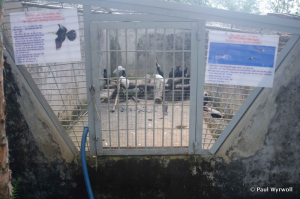 The day after my visit to U Minh Thuong I emailed the GIZ Project Manager with my concerns. The response on the same day was that GIZ did not condone the practices I had witnessed and that the Project Manager was not aware of the situation having not visited the park for over a year. Further, the Project Manager stated that my email would be translated and forwarded to the Vice-Chair of the biosphere reserve and the national park Director, and that the Project Manager would follow up with these officials personally after the Tet holiday (January 28 to February 5).
The day after my visit to U Minh Thuong I emailed the GIZ Project Manager with my concerns. The response on the same day was that GIZ did not condone the practices I had witnessed and that the Project Manager was not aware of the situation having not visited the park for over a year. Further, the Project Manager stated that my email would be translated and forwarded to the Vice-Chair of the biosphere reserve and the national park Director, and that the Project Manager would follow up with these officials personally after the Tet holiday (January 28 to February 5).
On February 8 I was copied into an email chain sent by a GIZ national staff member to the Project Manager. It contained a response to my original email in Vietnamese from the national park Director and a summary in English produced by the GIZ staff member. The summary stated that the park was engaged in rescuing wildlife: the Siamese crocodile was received from a local children’s centre, and the otters came to the park with the support of Wildlife at Risk (WAR), an NGO based in Ho Chi Minh City which “aims to combat the illegal wildlife trade and promote the conservation of endangered species”. The response also indicates that the animals were being kept with the intent of improving their health and then releasing them into their habitat. Finally, the response stated that the national park management wish to host a wildlife rescue centre in the park and they are seeking support to do this.
After being copied into this email I sent three subsequent emails to the GIZ Project Manager over the next few weeks enquiring about the planned discussions with the local officials and any subsequent outcomes. I received no reply. [An earlier version of this post was sent to GIZ (see the GIZ and DFAT statements below), and the response from GIZ indicates that the organisation is aware of the issue and “has been in regular communication with the park managers and is encouraging a change in the current practice”.]
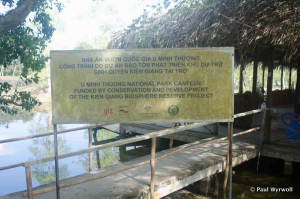 The objective of writing this blog post is to bring the situation at U Minh Thuong National Park to the attention of relevant personnel at GIZ and DFAT. My hope is that cooperation between these organisations could lead to a resolution in a manner that is consistent with the stated objectives of the KGBR Project.
The objective of writing this blog post is to bring the situation at U Minh Thuong National Park to the attention of relevant personnel at GIZ and DFAT. My hope is that cooperation between these organisations could lead to a resolution in a manner that is consistent with the stated objectives of the KGBR Project.
Of course, the provision of funding and technical support does not give a donor organisation the authority to control the actions of a local partner organisation. Promoting conservation in Vietnam is not an easy job; nor is providing safe captivity to any wild animal in many developing countries. But donors do have a responsibility to ensure that their funding is used in a manner that supports their objectives, to be aware of activities the local partner is undertaking that potentially undermines those objectives, and to actively implement and promote measures that assist the local partner in altering problematic activities.
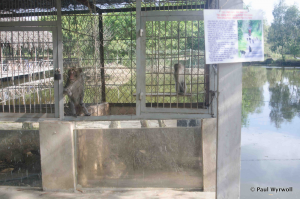 Supporting the construction of the tourist canteen next to the animal cages does not necessarily mean that KGBR Project funding has been used to build those cages, but it is indicative of broad support for the national park’s activities and the tourism infrastructure in the wetland. It is difficult to see how GIZ and DFAT can fund the structure where tourists are eating their lunch, but have no responsibility for the caged animals they are looking at whilst eating it.
Supporting the construction of the tourist canteen next to the animal cages does not necessarily mean that KGBR Project funding has been used to build those cages, but it is indicative of broad support for the national park’s activities and the tourism infrastructure in the wetland. It is difficult to see how GIZ and DFAT can fund the structure where tourists are eating their lunch, but have no responsibility for the caged animals they are looking at whilst eating it.
In addition, the delegated cooperation arrangement should not mean that DFAT is transferring to GIZ both funding and complete responsibility for how those funds are implemented. Ultimately, if the Australian aid program is paying, then it owns both the successes and the complications associated with the project.
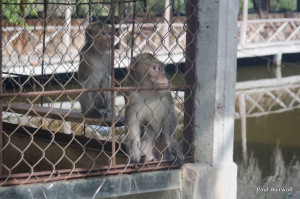 I am not in a position to recommend detailed solutions – these will probably be determined by institutional and funding arrangements known only to the stakeholders: GIZ, DFAT, WAR, the management of Kien Giang Biosphere Reserve and U Minh Thuong National Park, and relevant ministries of the provincial and national governments.
I am not in a position to recommend detailed solutions – these will probably be determined by institutional and funding arrangements known only to the stakeholders: GIZ, DFAT, WAR, the management of Kien Giang Biosphere Reserve and U Minh Thuong National Park, and relevant ministries of the provincial and national governments.
However, I would suggest that there are three main issues that the stakeholders could consider.
1. Improving the welfare of the captive wildlife. The national park Director has indicated that the animals would be returned to their natural habitat. If that is possible then measures supported by the best possible scientific information could be implemented to achieve this objective safely. If some of these animals have been held in captivity for an extended period, however, it is my understanding that re-entry may not be possible or successful. In that case, and assuming relocation to a safer location is not possible, measures to improve the conditions of captivity to an international standard and training of the national park staff in appropriate care could be considered. The existing involvement of WAR in the park’s activities, and their responsibility for placing the otters there, seemingly provides a logical project partner for GIZ and DFAT to work with in such a situation. Alternatively, there are other NGOs operating in Vietnam with relevant technical expertise, such as Animals Asia.
2. Ensuring that U Minh Thuong National Park plays a positive role in educating visitors on the importance of biodiversity conservation. U Minh Thuong has a range of tourism infrastructure, including the wetland structures, sight-seeing boats, large concrete viewing platforms, among others. Due to the scarcity of natural areas remaining in the Mekong Delta and local history – the park was a base for Viet Cong activities during the US-Vietnam war – the site already attracts domestic and international visitors. And the KGBR Project is actively seeking to increase visitation [pdf]. From an international perspective, there are many countries where the current condition of the captive wildlife would be deemed unacceptable. Witnessing such conditions is unlikely to stimulate favourable Tripadvisor reviews. From a domestic perspective, the park has an opportunity to help change commonly-held social values towards animals, particularly the consideration of wildlife as resources with no intrinsic value in their habitat. That opportunity is currently being missed by the park’s management, GIZ and DFAT.
3. Accountability within and evaluation of the Kien Giang Biosphere Reserve Project. In addition to resolving the immediate situation in U Minh Thuong National Park, I would suggest that there are a number of issues related to accountability and evaluation that relevant stakeholders may wish to consider. [In this context, it is worth noting that: the latest updates on this project on the DFAT website date from 2010 and 2011; GIZ lists the larger multi-province coastal management project on its website, but there is no documentation or specific reference to the KGBR; and, although the KGBR site provides links to project documents relating to phase one, there does not appear to be any evaluation material related to phase two.]
- Why was GIZ, and presumably DFAT, not aware of wildlife being held in captivity in one of the principal KGBR Project areas and what evaluation measures were in place that could have detected the issue?
- Was the construction of the enclosures financed through KGBR Project funding?
- Does U Minh Thuong park management have a scientifically developed plan for the rehabilitation of the wildlife and re-entry to their habitat?
- Other than the crocodile and the otters, what are the origins of the other animals in captivity, such as the macaque monkeys that are endemic to the natural areas of the park?
I have sought here to provide an accurate overview of my knowledge of the situation I witnessed at U Minh Thuong National Park, but I am not an expert in aid implementation. I do not presume that I have the answers to the problem or fully understand how it came into being.
I hope that raising these issues here will stimulate the relevant stakeholders to work together to address the problem. I also hope that GIZ, DFAT and other parties will provide their responses to this article and information on subsequent actions.
GIZ Vietnam, the Australian aid program in the Hanoi Embassy, and DFAT in Canberra were provided with an earlier version of this post in advance of publication and an opportunity to provide a response. The responses can be viewed below.
Paul Wyrwoll is a PhD student in Economics at the Crawford School of Public Policy, ANU.
Dr. Christian Henckes, Director, Integrated Coastal Management Program, GIZ Vietnam:
“GIZ has been aware of wildlife being held in captivity in U Minh Thuong National Park. GIZ understands that they are not in keeping with western standards and has been in regular communication with the park managers and is encouraging a change in the current practice.
GIZ has at no point funded any activities or equipment and material to support keeping wild animals in captivity.
GIZ has no evidence where the animals come from. In the discussions with the park management GIZ staff was told that some animals were taken from poachers and apparently are injured and not able to be released.
U Minh Thuong park considers it important for the many tourists that visit the park to see these rare animals. It also argued that if released into the wild, they would not survive or would be captured and killed.
GIZ is taking this issue seriously and can help to identify possible solutions or improvements with the park management. However, it is not planned that GIZ is going to be actively involved in specific wildlife protection measures.
GIZ activities in Kien Giang cover the fields of
- Mangrove reafforestation,
- coastal management,
- livelihood for poor women and disadvantaged people and,
- environmental awareness raising.”
A spokesperson from the Department of Foreign Affairs and Trade:
“The Climate Change and Coastal Ecosystems Program (CCCEP) is working across five provinces of the Mekong Delta, and at the national policy level, to improve the management and protection of coastal ecosystems in the context of climate change. It also seeks to improve the resilience of communities that rely on these ecosystems for their livelihoods and food security. U Minh Thuong National Park in Kien Giang province is one of a number of locations where CCCEP activities are being implemented.
Australia is providing up to A$18 million (2011-17) for CCCEP in partnership with Germany.
Australia provides funding for CCCEP through a delegated cooperation agreement with Germany, under which GIZ (Deutsche Gesellschaft für Internationale Zusammenarbeit) is the implementing partner. GIZ is responsible for:
- implementing CCCEP activities;
- administering Australia’s financial contribution;
- applying environmental due diligence to the use of CCCEP funds; and
- reporting to DFAT annually on progress.
CCCEP activities do not include supporting construction of wild animal enclosures or keeping wild animals in captivity, and GIZ advises that CCCEP funding has not been used to support such activities.”



I am in Saigon at the moment and went on a day tour to the Mekong delta on Kim tours. We went to a animal park for lunch, the conditions were very bad, the horses attached to carriages where in the hot sun, panting heat stress I told them to move them to the shade they laughed at me. Huge white python in a cage with no water. Porcupines in cement cages nothing else. Horrific if Australia is supporting this. Please let me know who I can contact in Australia regarding this.
Angela
Hi Paul – you’re absolutely correct to publicise this problem. Congratulations on your clearly exacting and comprehensive piece of work. The photographs tell the story of the animals’ welfare conditions eloquently.
I’m disturbed by the reply from Dr Henckes, which in my opinion is quite unsatisfactory.
It is abundantly clear that GIZ has power to effect improvement in the animals’ conditions. Dr Henckes acknowledges that “GIZ has been aware of wildlife being held in captivity in U Minh Thuong National Park … not in keeping with western standards … “. Dr Henckes goes on “U Minh Thuong park considers it important for the many tourists that visit the park to see these rare animals”.
In other words, GIZ recognises the cruelty being inflicted on these unfortunate animals. But GIZ goes on to say that it is important for humans to be able to see them – in other words, Dr Henckes provides support for the animals’ current conditions. If GIZ were serious about the animals’ condition they would not put forward the claim that “it also argued that if released into the wild, they would not survive or would be captured and killed”. This statement, unsupported by evidence, goes no way to justify animal cruelty. If this were true (an unlikely case, as veterinarians could readily advise as to which animals would be unaffected by habituation and therefore able to survive in the wild – probably a sizeable number) why doesn’t GIZ seek an undertaking that no further animals will be taken from the wild? Dr Henckes is silent on this point in his reply – why? If GIZ is concerned about the animals’ welfare (it acknowledges they are kept in unsatisfactory conditions) surely they would be adamant that no further animals would be captured?
Providing an opportunity for animals to be viewed by humans can never be an ethical basis for animal cruelty. It is up to western nations, especially when they have funding leverage, to do what they can to improve the lives of both humans and animals – especially when the funding leverage is part of an environmental programme.
Paul, I again congratulate you for bringing this to the world’s attention, and for publishing the responses from those who have an ability to influence a better outcome for these unfortunate animals.
Alastair Lucas AM
Thank you for your comment Alistair.
You are certainly correct that GIZ has the power and responsibility to improve the situation in the park. And I would add that DFAT does as well.
You mentioned that a statement by Dr Henckes is unsupported by any evidence. Unfortunately, there is no evidence available to substantiate how and/or why the situation has occurred at all. One hopes that GIZ and DFAT are currently in the process of collecting that information, they will share it in a transparent manner, and will use it as the basis of substantive action.
Cheers,
Paul